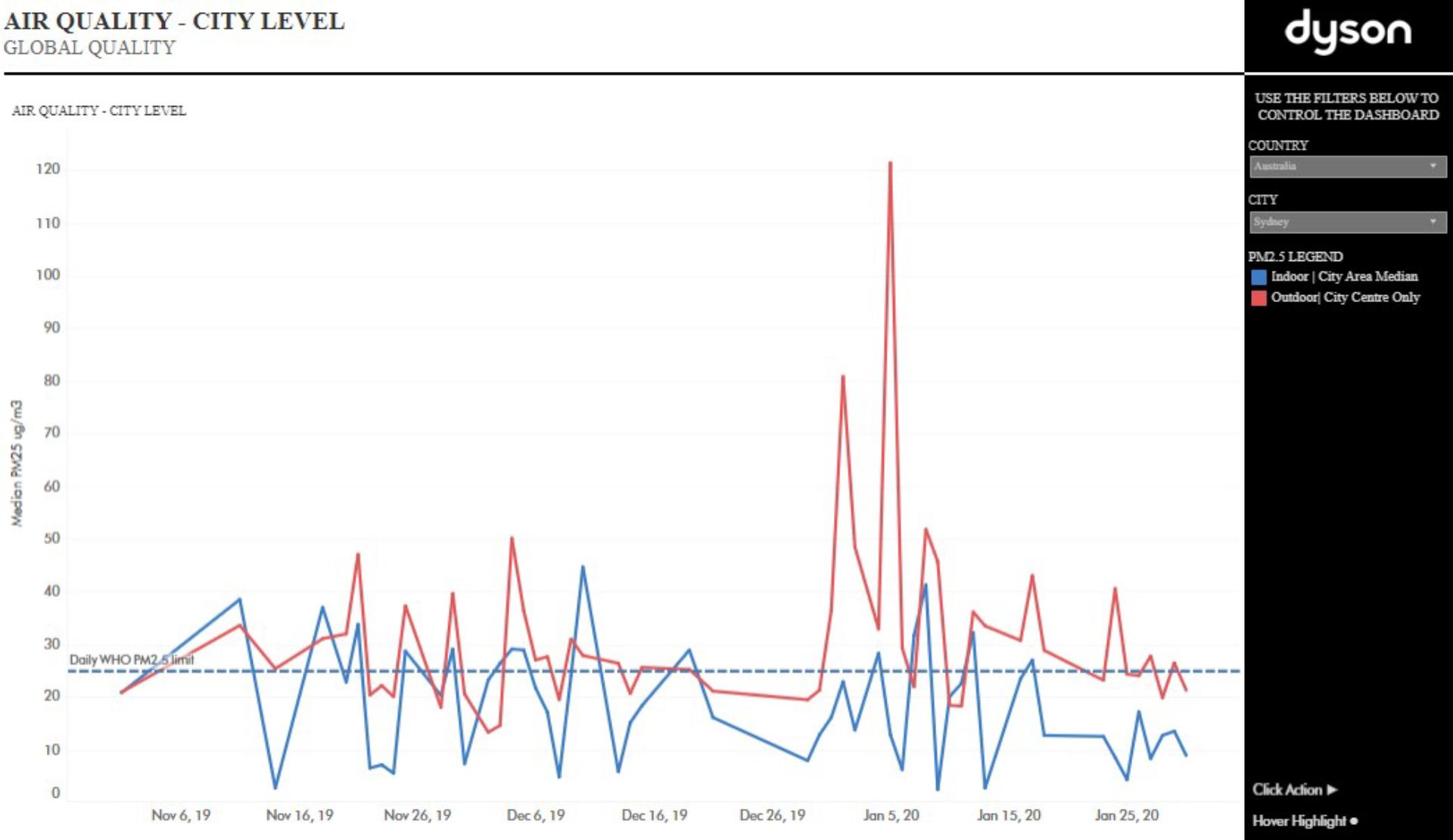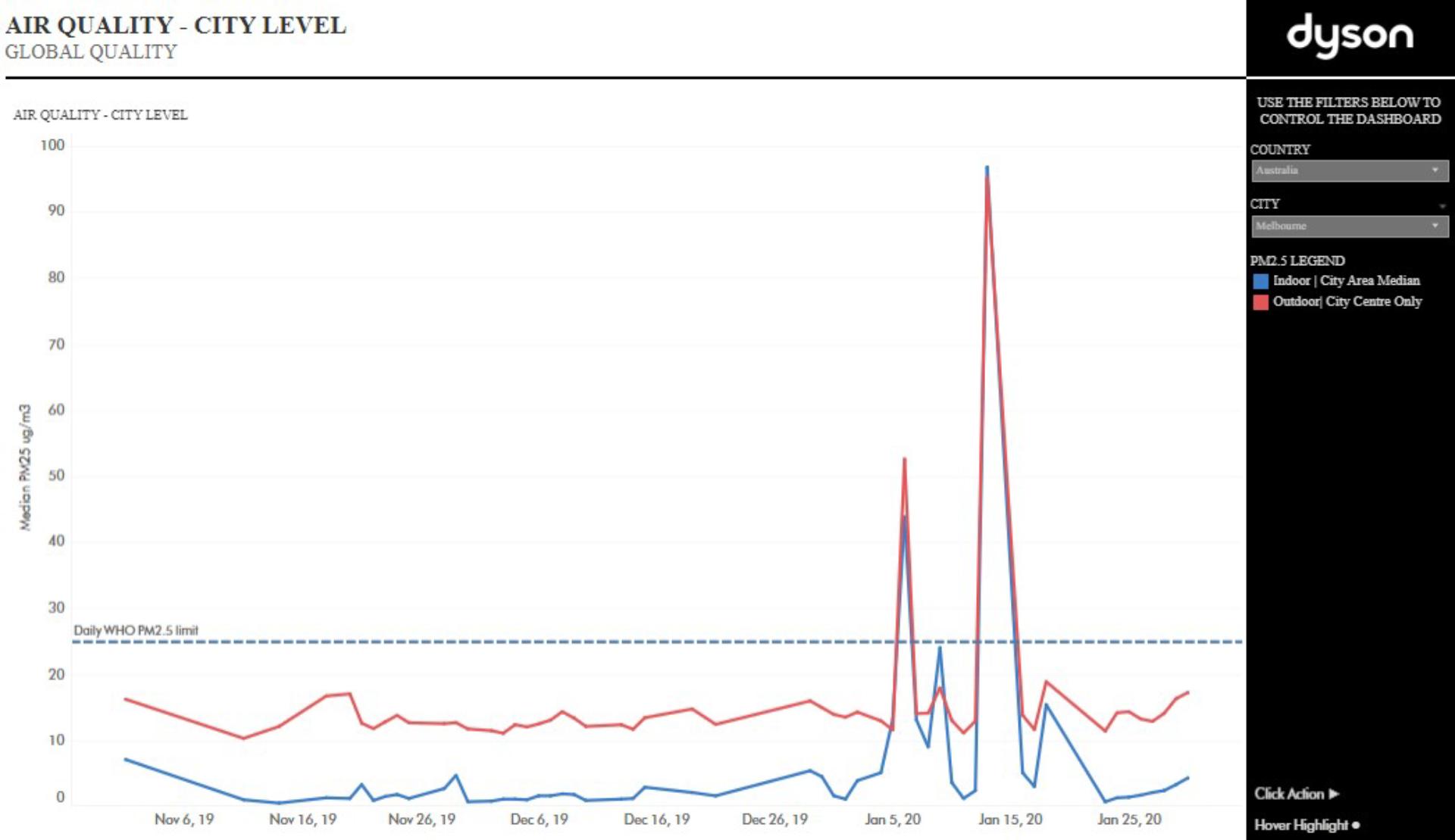
How to reduce your exposure to bushfire smoke
Alongside devastating destruction, one of the main impacts of bushfires is the smoke that can travel long distances, and linger for hours, days and sometimes weeks. Leading air quality and health expert Professor Sotiris Vardoulakis and Dyson engineer David Hill provide advice on how to reduce your exposure to bushfire smoke.
December 2020

Bushfire smoke is a mixture of different sized particles, water vapour and gases, including carbon monoxide, carbon dioxide and nitrogen oxides. According to Professor of Global Environmental Health, Sotiris Vardoulakis, at the Australian National University (ANU) Research School of Population Health, “Bushfires and backburning emit large and small particles that can be dispersed in the air over long distances. Bushfire smoke inhalation symptoms can include irritated eyes, nose, and throat."
"Very small particles can penetrate deeper into our respiratory system, reach our lungs and even translocate into the blood stream. This can cause inflammatory responses and affect several body organs. Smoke from fires also contains toxic gases, such as carbon monoxide and nitrogen oxides.”
Professor Vardoulakis continues, “We’re often exposed to many different types of air pollution both outdoors and indoors and the health effects of air pollutants can depend on the individual. Certain groups may be particularly sensitive to the effects of air pollutants and bushfire smoke, including young children, pregnant women, the elderly, and the one in nine Australians who suffer from respiratory health conditions such as asthma, hay fever or bronchitis.”
Just as wind patterns can accelerate and change the direction of fires, it can also determine how far and where wildfire smoke can travel. Recent data from Dyson connected purifiers in Sydney and Melbourne regions have shown several spikes in poor air quality, both indoors and outdoors, with levels reaching above the daily WHO PM2.5 limit likely due to smoke from nearby bushfires from November 2019 to February 2020.
Reports of orange skies and bushfire smoke haze across areas of New South Wales and Victoria in January 2020 show how visible bad air quality can be. But in other cases, air pollution can be much less visible. For example, while you may not see the same haze inside your home, it is likely that some of that air pollution is making its way inside. In fact, outdoor PM2.5 – such as those particles emitted from bushfires – is known to have a higher infiltration rate into homes, compared to the course and ultrafine PM size ranges.1
-
Sydney Air Quality

-
Melbourne Air Quality

“The quantity and composition of smoke from bushfires or backburning depends on the type of vegetation, temperature of combustion, and weather conditions. Uncontrolled fires can produce larger quantities of smoke that can travel very long distances in the air and affect people living hundreds of kilometres away from the fires. Smoke from backburning typically has a more localised impact, which can also affect the health of communities living in the area,” says Vardoulakis.
Modern home design often contributes to this problem further with homes now better sealed, leading in certain cases to static air and bad circulation of airflow within the home.2 Pollution can build up but purifying the air with a HEPA filter can help combat this if air cleaning performance is delivered around the whole room, with powerful airflow projection.
Professor Vardoulakis explains, “Air purifiers with HEPA filters, when appropriately used, can reduce exposure to smoke particles and significantly improve indoor air quality. Air purifiers with sealed HEPA filters combined with activated carbon filters can provide added protection from smoke as well as keep the air clean of everyday pollutants found in our homes.”
“First and foremost, education around the types and sources of air pollutants is paramount,” says Professor Vardoulakis. “People should consider adjusting their daily behaviours to mitigate the risks associated with air pollution, even outside of the bushfire season. Try avoiding busy highways, commute to work differently, increase ventilation when cooking, use more environmentally friendly cleaning products or use a purifier with a HEPA filter inside the home.”
How can you reduce your exposure to bushfire smoke?
Dyson Design Engineer David Hill shares the following actions:
1. Stay inside as much as possible
Unless you are asked to evacuate your area, staying inside can reduce your exposure to smoke, ashes and other air pollution. However, indoor air can still be impacted by outdoor pollution. Studies have shown that some air pollution can infiltrate indoors even through closed windows.3
2. Take extra precautions to protect the air in your home
Even the most well sealed home can still allow for some outdoor air pollution to make its way inside. Air purifiers with sealed HEPA filters and activated carbon filters can provide added protection from smoke as well as keep the air clean of everyday pollutants found in our homes such as dander from pets, fumes from gas stoves or volatile organic compounds (VOCs) from beauty products like hair spray.
3. Make kids a priority
According to The Thoracic Society of Australia and New Zealand, protecting the development and health of the lungs of children under five will impact the future respiratory heal and quality of life for the population.4 Make sure your children take the same – if not more - precautions to reduce their exposure. Consider moving existing purifiers or adding new ones to their bedrooms overnight.
4. For those who must go outside, wear an effective mask
If you must go outside, be sure to protect yourself by wearing an effective mask. According to Professor Vardoulakis, planning our daily activities to reduce exposure to outdoor pollution, and creating a clean air space in our own homes by keeping doors and windows shut and using an air purifier with a HEPA filter, is probably the best option for most families.
Professor Sotiris Vardoulakis has been working alongside Dyson through its air quality backpack study in Sydney. Reworking existing technology used in its air purifiers, two Dyson prototype air quality backpacks were given to two Australian families to detect the air quality around them during their daily lives. The results from one of the participants, a Sydney-based mother, found spikes in air pollution including PM2.5, NO2 and VOCs during routine activities such as cooking, cleaning and travelling by car.
[1] Liu et al (2003). Particle Penetration through Building Cracks. Aerosol Sci Technol 37:565-573; Liu et al (2001) Modeling pollutant penetration across building envelopes. Atmos Environ 35:4451-4462; Long et al (2001) Using Time- and Size-Resolved Particulate Data to Quantify Indoor Penetration and Deposition Behaviour. Environ Sci Technol 2001 35:2089-2099
[2] Vardoulakis S., Giagloglou E., Steinle S., Davis A., Sleeuwenhoek A., Galea K.S., Dixon K., Crawford J.O., 2020. Indoor Exposure to Selected Chemical Air Pollutants: A Systematic Review. International Journal of Environmental Research and Public Health 17, 8972; doi:10.3390/ijerph17238972
[3] Wang et al (2016) Indoor-outdoor relationships of PM2.5 in four residential dwellings in winter in the Yangtze River Delta, China. Environ Pollut 215:280-289
[4] Hole DJ et al. Impaired lung function and mortality risk. BMJ 1996;313: 711–5.
Dyson Newsroom
The latest news from Dyson
Press Contact
ANZ Press Office
Email: aupressoffice@dyson.com
 Call us
Call us Email us
Email us Request a meeting
Request a meeting Live chat
Live chat